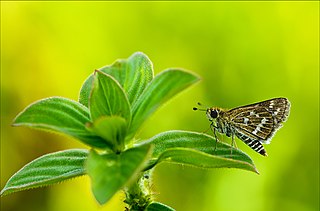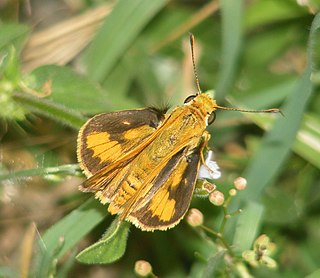
Bibasis gomata, commonly known as the pale green awlet, is a butterfly belonging to the family Hesperiidae. It is found in Northeast India, the Western Ghats and parts of Southeast Asia. The butterfly was reassigned to genus Burara by Vane-Wright and de Jong (2003) and is considered by them to be Burara gomata.

Burara jaina, the orange awlet, is a species of hesperid butterfly found in Asia. The butterfly was reassigned to the genus Burara by Vane-Wright and de Jong (2003), and is considered Burara jaina by them.

Hasora badra, the common awl, is a butterfly belonging to the family Hesperiidae, which is found in India.

Hasora chromus, the common banded awl, is a butterfly belonging to the family Hesperiidae which is found in the Indian subcontinent, Southeast Asia and Australia.

Aeromachus dubius, the dingy scrub-hopper, is a butterfly belonging to the family Hesperiidae. It ranges from India to China, including Malaya, Assam, Myanmar, Laos, Vietnam, Hainan and Yunnan.

Aeromachus pygmaeus, the pygmy scrub-hopper is a butterfly belonging to the family Hesperiidae. The species range is from India to Burma and Thailand.

Caltoris canaraica, the Kanara swift, is a butterfly belonging to the family Hesperiidae.

Halpe porus, commonly known as Moore's ace, is a species of butterfly in the family Hesperiidae, found in India.

Quedara basiflava, the yellow-base flitter or golden flitter, is a butterfly belonging to the family Hesperiidae and is endemic to India's Western Ghats.

Sovia hyrtacus, the bicolour ace or white-branded ace, is a butterfly belonging to the family Hesperiidae. It is found in Western Ghats from Goa to Kerala.

Taractrocera maevius, the common grass dart, is a species of butterfly belonging to the family Hesperiidae. It is found in India, Sri Lanka and Myanmar.

Telicota colon, commonly known as the pale palm dart or common palm dart, is a species of butterfly in the family Hesperiidae. It is found from India to Australia.

Thoressa astigmata, the southern spotted ace, is a butterfly belonging to the family Hesperiidae. The species was first described by Charles Swinhoe in 1890. It is endemic to the Western Ghats of India and is found in the states of Kerala, Tamil Nadu and Karnataka.

Gerosis bhagava, also known as the common yellow-breast flat, is a species of butterfly in the family Hesperiidae.

Spialia galba, the Indian grizzled skipper, is a hesperiid butterfly which is found in South Asia and parts of Southeast Asia.

Luthrodes pandava also called the Plains Cupid or cycad blue, is a species of lycaenid butterfly found in South Asia, Myanmar, United Arab Emirates, Indochina, Peninsular Malaysia, Singapore, Taiwan, Java, Sumatra and the Philippines. They are among the few butterflies that breed on cycads, known for their leaves being toxic to most vertebrates.

Spalgis epius, commonly known as the apefly, is a small species of butterfly found in the Indomalayan realm that belongs to the lycaenids or blues family. It gets its name from the supposed resemblance of its pupa to the face of an ape.

Byblia ilithyia, the spotted joker or joker, is a species of nymphalid butterfly found in parts of Africa and Asia.

Arhopala amantes, the large oakblue, is a species of lycaenid or blue butterfly found in Asia.

Parnara bada, the African straight swift, grey swift or Ceylon swift, is a butterfly of the family Hesperiidae. It is found in south-east Asia, from India through China to Indonesia, as well as the north-east coast of Australia.





















